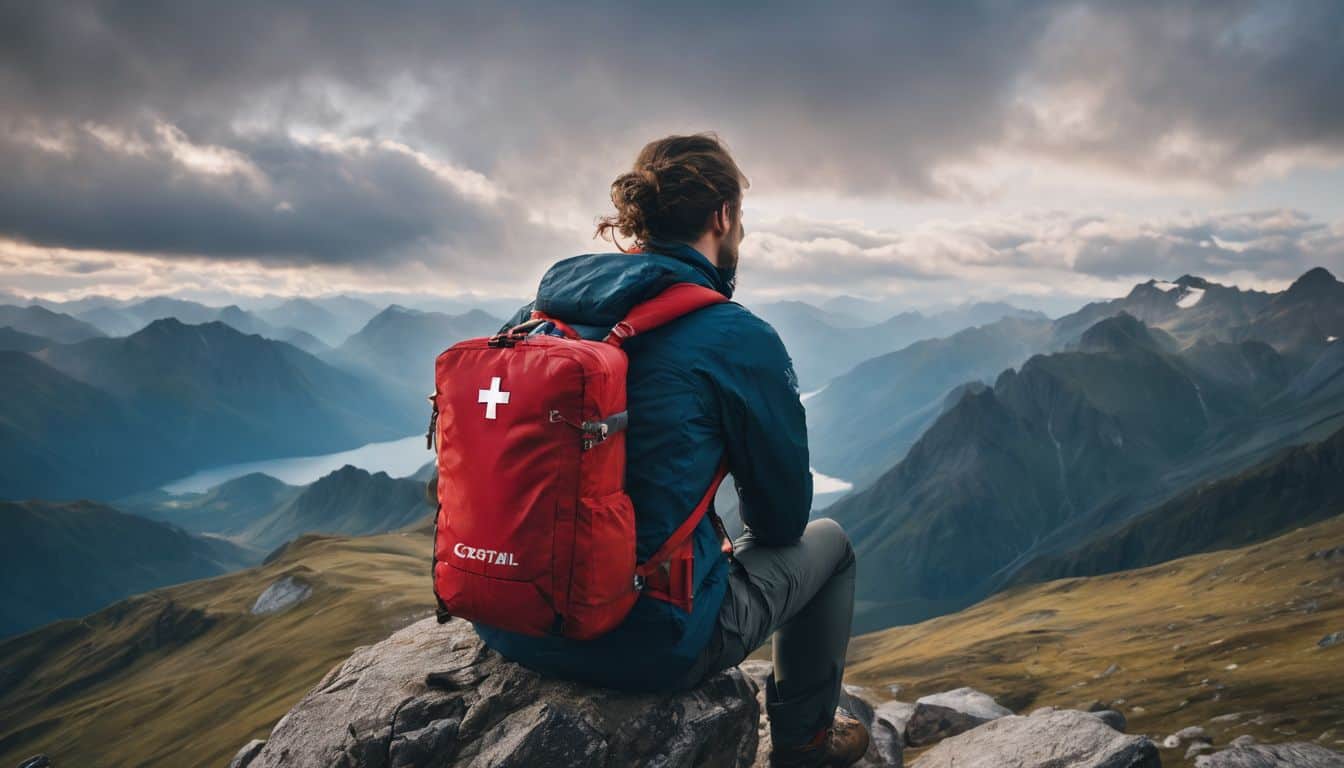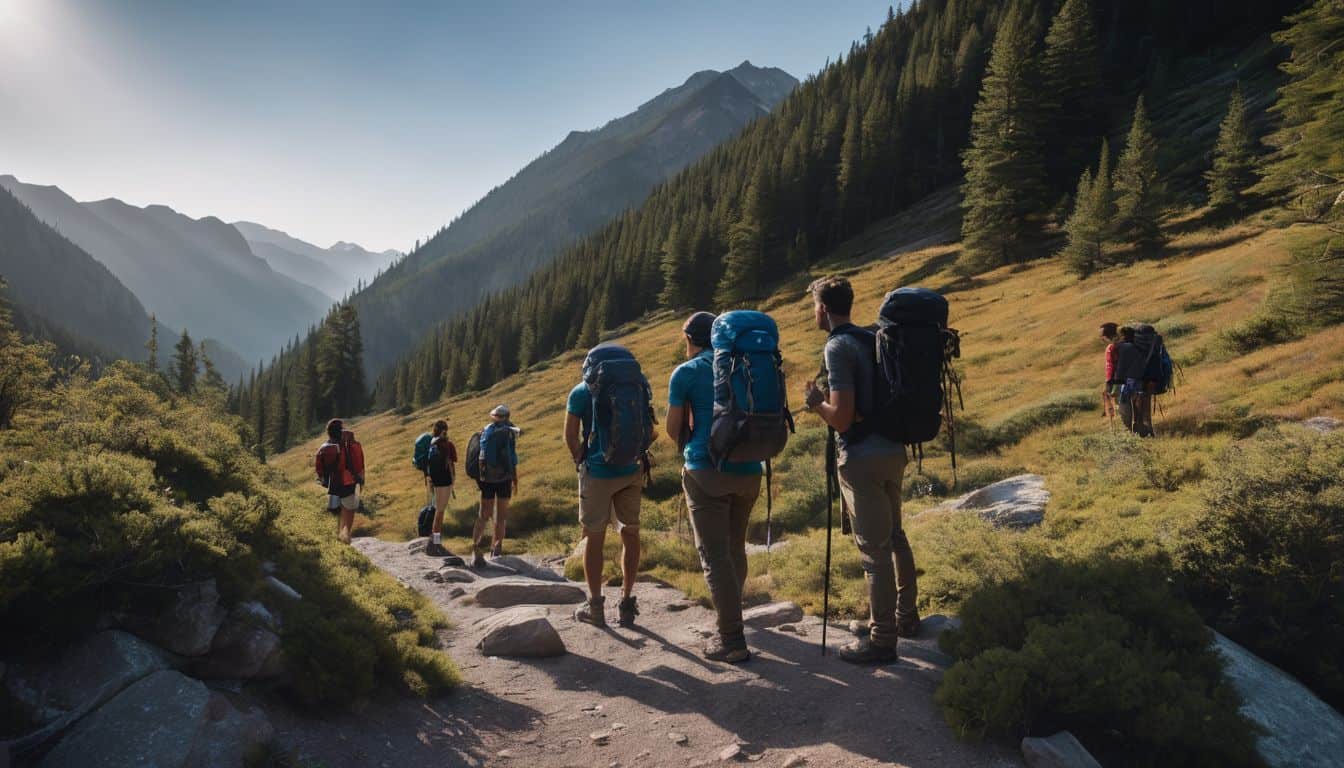Believe me, you’re not the only one reaching for an ice bag after a grueling hike up that steep hill. As someone who constantly surrenders to the call of nature and hiking trails myself, I know all too well the subsequent muscle agony we’ve all danced with at some point.
Over time, this has sparked a curiosity in me to dig into reliable researches for effective recovery strategies post-hike. This blog is going to delve into three science-backed methods that can expedite your bounce-back: nailing down a beneficial stretch routine, keeping hydration front-and-center and giving your feet some much-needed TLC.
Got your attention? Let’s dive in and make those next day soreness a thing of the past!
Key Takeaways
- Stretching after a hike reduces muscle tension, improves flexibility, and prevents injuries.
- Rehydrating immediately after the hike helps replenish lost fluids and electrolytes, supporting muscle recovery and preventing fatigue.
- Taking care of your feet through massage, soaking in Epsom salts, using foot products like Trail Toes, and wearing good-quality insoles can alleviate discomfort and promote foot health.
- Using self-recovery tools like foam rollers for muscle relaxation and targeted massage with a tennis ball can help speed up post-hike recovery.
The Importance of Post-Hike Recovery
Proper post-hike recovery is crucial for minimizing muscle tension, relieving pain, and promoting overall relaxation.
The benefits of cooling down before resting
Cooling down before you rest helps your heart rate get back to normal. After a big hike, instead of just stopping and resting, cool down first. Active cool-down is better than just sitting or lying down.
By walking at a slow pace or doing some light stretching, you help your body adjust from working hard to rest mode. This also keeps your balance in check and improves posture. Most importantly, it can stop injuries from happening later on because all the stiffness gets worked out during this time!
The importance of proper hydration and nutrition
Water and food are key after a hike. It’s vital to drink water for hydration. Water helps your body use minerals, vitamins, amino acids, and other stuff. This is all part of staying healthy after a hike.
Eating good food also helps get energy back and eases soreness in the muscles. You stop muscle damage by drinking plenty of water and eating well too. Some people also add electrolyte supplements to their water for better fluid hold and taste which helps them drink more.
A Comprehensive Guide to Post-Hike Recovery Methods
After a good hike, your body needs proper care. Hydrate right away to get rid of thirst and dryness. Eat food packed with protein for muscle repair. Use cool down time wisely, don’t just sit or lie down right away after your hike.
This might make you feel dizzy or fatigued.
Stretching is key here too! Your muscles will thank you later for a few minutes spent on stretches now. Take extra care of your feet – they do most of the hard work! A warm soak helps ease tired feet.
As part of recovery tools, use a foam roller to relax stiff muscles and increase blood flow. Try cold treatments as it’s also great for sore muscles!
Sleep works like magic when it comes to recovery – nothing beats getting lots of zzz’s! During light activity days, let your body rest but keep moving slowly.
You can turn to gear buddy like compression clothes that aid in quicker recovery by keeping blood circulation smooth and trekking poles that help lessen pressure on knees while hiking downhill.
Natural remedies can work wonders too! Applying natural products like arnica cream quickens healing by relieving pain.
Electrolytes help balance water levels in your body and speed up muscle repair process.
Eating smart plays a role too in how fast our bodies recover from strenuous activity. Be sure to eat meals full with vitamins and minerals needed for repairing tissues damaged during the hike.
The road to post-hike recovery is not easy but having the right mindset makes things smoother indeed; Always know why taking time off from training is important – believe it’s not wasted time rather an investment so you come back stronger next time!
Remember, everyone has their own methods- explore what suits best for you and stick on it.
Effective Post-Hike Recovery Tips
Stretching after a hike helps to reduce muscle tension and relieve pain.
Importance of stretching after a hike
Stretching after a hike is really important. It helps reduce the risk of injury and can also help with sore muscles. Stretching increases flexibility and improves your range of motion.
It’s a great way to prepare your body for proper post-hike recovery. By stretching, you can get rid of toxins in your muscles and prevent chronic injuries. So, make sure to stretch before and after your hike to reduce any aches or pains you may have experienced!
Rehydrating immediately after the hike
After a long and strenuous hike, it’s important to rehydrate your body as soon as possible. Drinking water throughout the hike is not enough to maintain proper hydration levels. Rehydration is crucial for fast post-hike recovery because it helps replenish lost fluids and electrolytes in your body.
When you’re dehydrated, your muscles may take longer to recover, leading to fatigue and increased risk of injury. By rehydrating immediately after the hike, you can support muscle recovery and ensure that your cells are functioning properly.
Remember, water is essential for keeping your body in top shape!
Caring for your feet
Taking care of your feet is essential for a successful post-hike recovery. Massaging your feet after a hike helps increase blood flow and circulation, providing relief from any discomfort or pain.
Soaking your feet in Epsom salts for about 20 minutes can also be beneficial since it helps relax muscles and reduce inflammation. Using products like Trail Toes can condition your feet, keeping them healthy and aiding in the recovery process.
Don’t forget to stretch and massage the arches of your feet as well to prevent or treat conditions like plantar fasciitis. Investing in good-quality insoles, such as Superfeet, can provide additional support and help prevent foot issues during hikes.
Using Self-Recovery Tools
One effective self-recovery tool is using a foam roller to release muscle tension and promote relaxation. Discover more tips and techniques for post-hike recovery in our blog!
Using a foam roller
Foam rolling is a great way to help your muscles recover after a hike. It’s like giving yourself a massage! Foam rolling targets the fascia, which is the connective tissue that holds your muscles in place.
By using a foam roller, you can release any tightness or tension in your muscles and promote muscle repair. This can be especially helpful if you’ve experienced muscle damage during your hike.
Foam rolling can also reduce post-exercise soreness and stiffness, so you’ll feel better faster. There are different types of foam rollers available, so you can find one that works best for you and optimize your training and performance.
Trying hot or cold treatments
Hot or cold treatments using self-recovery tools are a great way to help your body recover after a hike. You can start with a warm shower and gradually lower the temperature to promote recovery.
This thermal therapy helps relax sore muscles and reduce inflammation. Running cool water on your legs is another simple yet effective method for post-hike recovery. It improves circulation and provides relief to tired muscles.
On the other hand, applying heat to your skin, like taking a warm shower or using heating pads, can also provide comfort and aid in muscle treatment. Cold baths are particularly helpful for speeding up muscle recovery as they have anti-inflammatory properties.
Using a tennis ball for targeted massage
I love using a tennis ball for targeted massage after a hike! It’s such an easy and effective way to relax my muscles, reduce stress, and improve my sleep quality. Plus, it helps with pain relief and prevents injuries.
The best part is that it’s cost-effective and user-friendly – I can do it anywhere, anytime with very little space. Adding tennis ball massage to my post-hike recovery routine has made a noticeable difference in how quickly I recover.

The Role of Rest and Sleep in Recovery
Getting a good night’s sleep is crucial for recovery after a hike, as it allows your body to repair and rejuvenate itself, reducing muscle soreness and improving overall performance.
The importance of a good night’s sleep
Getting a good night’s sleep is crucial for your post-hike recovery. It helps boost your immune system, reducing the risk of getting sick. Sleep also allows your body to recharge and repair the muscles you used during your hike, keeping them strong and ready for future adventures.
Plus, adequate sleep supports your mental health, ensuring that you are in the right mindset for optimal recovery. So make sure to prioritize quality sleep to reap all these benefits and keep yourself healthy and energized.
Allowing for active rest days
Active rest days are an important part of post-hike recovery. When we give our bodies a break from intense exercise, it doesn’t mean we just sit around doing nothing. Instead, active rest days involve engaging in low-impact activities that promote blood flow and help our muscles recover.
By incorporating a gentle workout or some light movement on these days, we can stimulate our body without causing additional stress. This type of restorative exercise helps maintain training consistency and allows us to target specific areas for improvement.
So, instead of completely resting on your rest day, try going for a leisurely walk or bike ride to keep your body moving and aid in the recovery process.
Additionally, active rest days provide many benefits for both athletes and hikers alike. By engaging in low-impact activities, such as swimming or yoga, we can promote better blood circulation and reduce muscle soreness.
These activities also help with flexibility and joint mobility while giving our bodies a break from high-intensity workouts. Active rest days not only contribute to faster recovery but also serve as a way to enjoy physical activity in a lighter manner without putting excessive strain on the body.
Utilizing Recovery Gear
Use compression clothing to enhance circulation and reduce muscle fatigue, while trekking poles provide additional support and stability during hikes.
Wearing compression clothing
Compression clothing, like compression tights, is a great tool for recovery after a hike. Not only does it help reduce soreness and promote muscle relaxation, but it can also improve flexibility and prevent strains and pulls.
Studies have shown that compression garments support post-exercise recovery and enhance performance during exercise. So, if you want to recover faster from your hikes and keep your muscles in top shape, consider wearing compression clothing as part of your recovery gear.
It’s an effective way to take care of your body after intense hiking adventures!
Using trekking poles
Trekking poles are essential tools for any hiking enthusiast. They can make your hikes easier and safer by reducing the risk of falls and injuries. When crossing swift-moving water or trekking along narrow ridgelines, trekking poles provide balance and stability.
Additionally, they can be used for first aid and emergencies during a hike. You can even use them to probe into water or snow when necessary. Using trekking poles decreases muscle activity in your lower extremities and increases overall balance and stability, especially when carrying a heavy backpack or load.
So don’t forget to pack your trusty trekking poles on your next outdoor adventure!
Applying Natural Remedies
Incorporate natural topical products and electrolytes into your post-hike recovery routine for added relief and nourishment.
Using natural topical products
After a long hike, using natural topical products can be a great way to support your body’s recovery. Herbal remedies and essential oils can provide soothing relief for sore muscles and joints.
Aromatherapy can also help promote relaxation and reduce any feelings of stress or tension. Homeopathic treatments and natural healing methods are gentle on the skin and often free from harsh chemicals.
Plant-based products offer an alternative to traditional remedies, providing nontoxic skincare options for post-hike recovery. Incorporating these natural remedies into your routine can enhance your overall recovery experience.
Incorporating electrolytes in your recovery routine
When it comes to recovery after a hike or any physical activity, incorporating electrolytes in your routine is crucial. Electrolytes like sodium, potassium, and magnesium help with hydration and replenishing minerals lost through sweat.
By consuming electrolytes during your recovery period, you can optimize your sports recovery habits and get the most out of your training routine. These essential minerals aid in muscle repair, reduce fatigue, and enhance overall performance.
Whether you choose to drink sports drinks or use electrolyte tablets or powders, incorporating these vital nutrients into your post-hike recovery routine will help you recover faster and feel better for your next adventure.
Smart Eating Habits for Faster Recovery
Eat a well-balanced meal packed with nutrients and protein to aid in faster recovery after a hike. Incorporate anti-inflammatory foods like fruits, vegetables, and omega-3 fatty acids to reduce muscle inflammation and promote healing.
Consuming a well-balanced meal after a hike
After a long and challenging hike, it’s important to nourish your body with a well-balanced meal for quick recovery. Eating the right foods can help promote muscle repair and replenish your energy levels.
One key component of post-hike nutrition is protein intake. Consuming 15-25 grams of high-quality protein immediately after your hike is recommended to support muscle repair. Additionally, incorporating complex carbohydrates into your meal is crucial for replenishing glycogen stores in the body.
Lean protein sources like chicken or beans combined with whole grains or sweet potatoes make for an excellent post-hike meal that will aid in faster recovery. Remember to also include antioxidant-rich foods such as berries or leafy greens, which can assist in reducing inflammation and supporting overall healing after exercise.
Incorporating anti-inflammatory foods in your diet
Eating the right foods after a hike is crucial for faster recovery. One way to promote healing and reduce inflammation is by incorporating anti-inflammatory foods into your diet. These foods are rich in antioxidants and heart-healthy fats, which can help reduce exercise-induced inflammation.
Some examples of anti-inflammatory foods include berries, cherries, apples, leafy greens, tomatoes, peppers, nuts, and seeds. Other options like nuts, mushrooms, pulses (such as beans and lentils), salmon, sardines (rich in omega-3 fatty acids), and spices also have excellent anti-inflammatory properties.
By including these foods in your meals after hiking adventures, you can speed up recovery while strengthening your immune system and reducing cardiovascular risk.
Mindset and Motivation for Recovery
Stay focused on your recovery goals and remind yourself of the positive effects that proper post-hike recovery can have on your overall well-being and future hiking adventures. Connect with a supportive hiking community to stay motivated, share tips, and seek advice when needed.
Reminding yourself of the benefits of recovery
It’s important to remind ourselves of the benefits that come with post-hike recovery. When we recover properly, our muscles repair themselves, glycogen gets replenished in our bodies, and our mood improves.
Additionally, positive thinking plays a crucial role in addiction recovery and helps us maintain a hopeful mindset throughout the process. By focusing on these benefits, we can stay motivated to prioritize recovery after each hike.
Remembering how good it feels to give our bodies the rest they need will help us stay committed to taking care of ourselves and enjoying all the amazing hiking adventures ahead.
Joining a hiking community for support and advice
When it comes to recovering after a hike, joining a hiking community can be really helpful. Being part of a community of outdoor enthusiasts who share the same passion for hiking can provide you with the support and advice you need during your recovery.
It’s great to have people who understand what you’re going through and can offer guidance based on their own experiences. You can learn from their knowledge and gain motivation to keep going.
Hiking communities often have online forums or social media groups where you can connect with fellow hikers, ask questions, and get valuable tips that will help you recover faster and get back on the trail in no time.
Conclusion on Post-Hike Recovery Methods
In conclusion, post-hike recovery is crucial for a successful hiking experience. By incorporating stretching exercises, staying hydrated, and taking care of your body with self-recovery tools, you can alleviate muscle tension and promote faster healing.
Remember to rest and prioritize sleep, utilize recovery gear like compression clothing and trekking poles, apply natural remedies such as topical products and electrolytes, maintain smart eating habits, and stay motivated through community support.
With these effective tips in mind, you’ll be well-equipped to recover quickly from your hikes and enjoy more time on the trails!
FAQs on Post-Hike Recovery Methods
1. How long does it take to recover after a hike?
The recovery time after a hike can vary depending on factors such as the length and intensity of the hike, your fitness level, and any pre-existing injuries. Generally, it can take anywhere from a day to a week for your muscles to fully recover.
2. What are some effective tips for recovering after a hike?
Some effective tips for post-hike recovery include stretching or doing gentle yoga exercises, drinking plenty of water to stay hydrated, and getting enough rest and sleep. Additionally, applying ice or taking warm baths/showers can help soothe sore muscles.
3. Should I eat anything specific after a hike to aid in recovery?
After a hike, it’s important to refuel your body with nutritious foods that provide energy and aid in muscle repair. Opt for balanced meals that include lean protein (such as chicken or fish), carbohydrates (like whole grains or fruits), and healthy fats (such as avocado or nuts).
4. Can I resume normal activities immediately after a strenuous hike?
It is recommended to give your body time to rest and recover before resuming normal activities following a strenuous hike. Listen to your body’s signals of fatigue or pain before engaging in any rigorous physical activity.
5. Are there any specific stretches I should do after hiking?
Yes! Some recommended stretches after hiking include calf stretches (by leaning against a wall with one leg extended behind you), quad stretches (by standing on one leg while holding onto something for stability), and hamstring stretches (by sitting with one leg straightened out in front of you while reaching towards the foot). These will help release tension in key muscle groups used during hiking





Leave a Reply